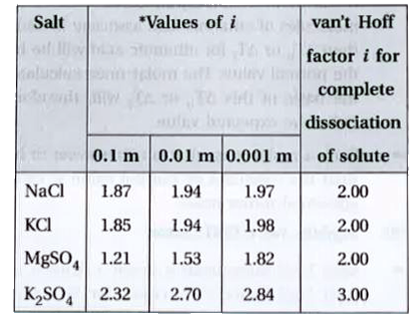Explain van't Hoff factor. Solution in Gujrati
Van.t Hoff introduced a factor i, known as the van.t Hoff factor, to account for the extent of dissociation or association. This factor i is defined as :
i=Normal molar massAbnormal molar mass
=Observed colligative propertyCalculated colligative property
i=Total number of moles of particles after association / dissociationNumber of molar of particles before asociation / dissociation
Here abnormal molar mass is the experimentally determined molar mass and calculated colligative properties are obtained by assuming that the non - volatile solute is neither associated nor dissociated.
In case of association, value of i is less than unity while for dissociation it is greater than unity, while when no association / dissociation, then i = 1
For example, the value of i for aqueous KCl solution is close to 2, while the value for ethanoic acid in benzene is nearly 0.5.
Inclusion of van.t Hoff factor modifies the equations for colligative properties as follows :
P01−P1P01=in2n1
Relative lowering of vapour pressure of solvent,
Elevation of Boiling point, ΔTb=iKbm
Depression of Freezing point, ΔTf=iKfm
Osmotic pressure of solution, π=iCRT=i(nV)RT

Topper's Solved these Questions
- BOOK - KUMAR PRAKASHANCHAPTER - SOLUTIONS EXERCISE - SECTION - A QUESTIONS (SELF - PRACTICE QUESTIONS)37videos
SOLUTIONS
- BOOK - KUMAR PRAKASHANCHAPTER - SOLUTIONS EXERCISE - SECTION - A QUESTIONS (TRY YOURSELF)29videos
SOLUTIONS
- BOOK - KUMAR PRAKASHANCHAPTER - SOLUTIONS EXERCISE - SECTION - E MCQs asked in GUJCET/Board Exam69videos
SOLUTIONS
- BOOK - KUMAR PRAKASHANCHAPTER - SAMPLE QUESTION PAPER EXERCISE - [PART-B] SECTION - C2videos
SAMPLE QUESTION PAPER
- BOOK - KUMAR PRAKASHANCHAPTER - SURFACE CHEMISTRYEXERCISE - SECTION - E (MCQs asked in GUJCET/Board Exams)52videos
SURFACE CHEMISTRY
Similar Questions
Given examples of gaseous solute and solvent.
01:50View SolutionIf 5.85 gm of NaCl is dissolved in 90 gm of water, then find out the mole fraction of NaCl.
View SolutionFreezing point of urea solution is −0.60C. How much urea is required to be dissolved in 3 kg water ? [M(urea)=60gmol−1,Kf=1.50C Kg mol−1]
03:33View Solution0.6 ml acetic and having the density 1.06 g mL−1 is dissolved in 1 litre water. It's shows the depression in freezing point of 0.020.5∘C. Calculate want haff factor and Ka of an acid.
01:31View SolutionName the catalyst [X] for the reaction,
CO(g)+H2(g)[X]−−→HCHO(g)04:30View SolutionWhat is Van't Hoff factor ?
54:33View Solutionvan't Hoff factor (i)
01:50View SolutionVan't Hoff factor is _____.
03:52View SolutionWhat is van't Hoff factor?
03:07View SolutionDefine Van't Hoff factor.
01:53View SolutionSolution | Van'T Hoff Factor
01:53View SolutionDiscuss the van't Hoff factor.
02:04View SolutionVan't Hoff factor is _____.
01:08:04View SolutionDefine Van't Hoff factor.
39:56View SolutionVan't Hoff factor(i):
06:18View Solution

